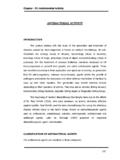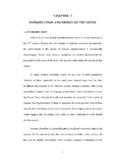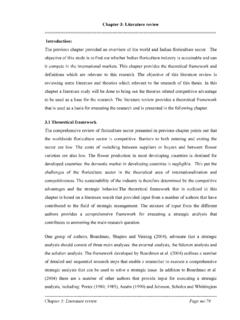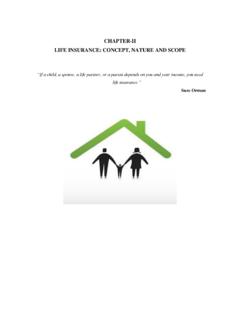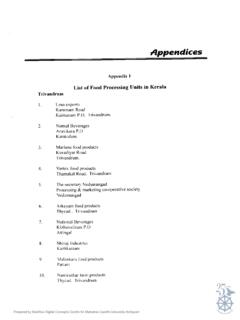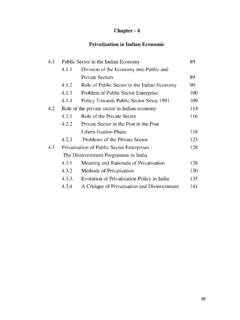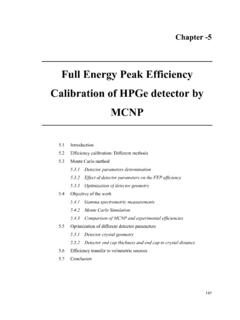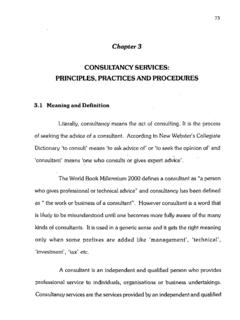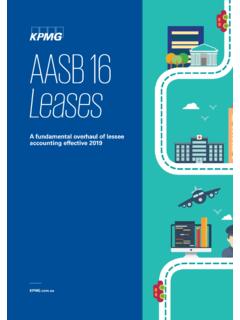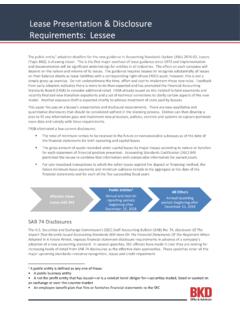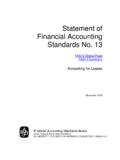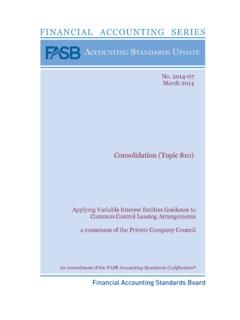Transcription of CHAPTER - 6 LEASE ACCOUNTING PRACTICES IN INDIA
1 CHAPTER - 6. LEASE ACCOUNTING PRACTICES . IN INDIA . 6. LKASK ACCOUNTING PRACTICES IN INDIA . INTRODUCTION. ACCOUNTING for leases has been a controversial subject among the accountants, community, practitioners in leasing industry and ACCOUNTING standards setters since the rise of the global popularity of leasing in the late 1950s and early 1960s. The reporting PRACTICES regarding leases have undergone a sea change over the past four decades, where once leases were neither disclosed nor reported, disclosure was slowly reported in the notes to the accounts and capitalisation of leased assets in the financial statements of the lessees. The main ACCOUNTING controversy pertains to the lessees'. financial statements. 'fhe ACCOUNTING issues of lessees are in respect of charging of LEASE rentpls to income and reporting of leased assets in the balance sheet. Similarly, two important acc'ounting issues in the case of lessor are the income recognition and disclosure of leased assets in the financial statements.
2 The main reason for the controversy could be the consideration of ownership of the leased assets. When ownership is considered on the basis of legal form, then lessor is the owner (de jure owner); but on the basis of financial and economic substance, the lessee , who bears the risks and rewards incidental to ownership is the owner (de facto owner). In countries like the USA, tiustralia, Germany and Japan, the ownership is recognised on the basis of economic substance and financial 182. reality and hence the lessee retains the tax benefits of the assets. While in the UK, France, Sweden and INDIA , the legal owner (lessor) of the asset continued to avail the tax benefit. The primary objective of this CHAPTER is to examine the LEASE ACCOUNTING PRACTICES of Indian leasing and lessee companies. For this purpose we have analysed the annual reports of leasing companies for five year period ( , 1983-84 to 1987-88), and lessee companies for three years ( , 1985-86 to 1987-88)and 28.
3 Lessors questionnaire responses. Before pres :nting the empirical analysis, we have provided a brief review of LEASE ACCOUNTING requirements under Financial ACCOUNTING Standard ( ), the Statement of Standard ACCOUNTING PRACTICES !, ( ), International ACCOUNTING Standard and Exposure Draft and Guidance Note on " ACCOUNTING for Leases" by the Institute of Chartered Accountants of INDIA . The main features of the LEASE capitalisation controversy is also presented. LEASE ACCOUNTING STANDARDS. THE STANDARDS. In the US, the importance of development of leasing was first recognised by the Securities and Exchange Commission (SEC) in its 15th Annual Report for the year ended June 30, 1949. In its report, the Commission pointed out the emergence of the sale of LEASE back as a m&jor financing device and the ACCOUNTING problems it created.. Efforts were made to develop standards of 183. LEASE ACCOUNTING by the in the United in Oetober, 1949, when the leasing industry was still in its infanc~ stage.
4 'l'he Committee on ACCOUNTING Procedure of the . American Institute of Certified Public Accountants issued ACCOUNTING Research Bulletins (ARB) No. 38 and No. 43 in this regard. During the issuance of Bulletin No. 38, a number of articles appeared in the journals calling attention to the growing importance of leases. Some writers favoured the footnote disclosures whereas others favoured the capitalisation of leases in the financial statements of lessees. The major argument was that whether the accountant should look through legal form of a transaction, or the financial substance of a transaction. During 1960s, leasing and more particularly ACCOUNTING for leases on the books of lessees has been a much explored subject. Accountants have not been alone in considering the subject, but the lawyers, economists, investment bankers, analysts and entrepreneurs have made their varying contributions. Myers (1962) concludes briefly that more information is desirable in the financial statements either in the body of the statement or in a note.
5 Gant R. ponald (1959), John L. Hennerty (1961), Robert W. Baltz (1960), and Gordon Shillinglaw (1958), strongly put forth their views in favour of balance sheet reporting of leases (capitalisation of leases) and Alvin Zises (1961) and Donald C. Cook (1963) viewed against the capitalisation of leases. 184. Financial ACCOUNTING Standard Financial ACCOUNTING Standard Board published in November 1976, its statement of Financial ACCOUNTING Standards No. 13, ACCOUNTING for Leases (FAS-13), which superseded ACCOUNTING Principles Board (APB) Opinion Nos. 5, 7, 27, 31 and paragraph 15. of the APB opinion No. 18. FASB Statement No. 13, " ACCOUNTING for Leases'' and its various amendments and interpretations specified the ACCOUNTING and reporting of leases by lessors and lessees. The Statement derives the classification from the view that a LEASE transfers substantially all the risks and rewards of ownership, it should be accounted for by the lessee as the acquisition of an asset and incurrence of an obligation.
6 The lessor, in turn, should account for it as a sale or financing (a sales type, direct financing or leveraged LEASE ). All other leases should be accounted for as operating leases. The main thrust of the FAS-13 is whether a lessor has transferred substantially all the risks and rewards of ownership of the asset to the lessee , if so, the LEASE is considered as finance LEASE . If the risks and rewards are not transferred, an operating LEASE results for both the lessee and the lessor. The important issues of FAS-13 are presented in the following paragraphs. LEASE Classification and ACCOUNTING : lessee 's Point of View For a lessee , if a LEASE meets one or more of four of the following criteria it is a capital LEASE ; otherwise it is classified as an operating LEASE . 185. 1. Tho LEASE transfers ownership of the property to the lessee by the end of the LEASE . 2. The LEASE contains a purchase option. ~- The LEASE term is equal to 75 per cent or more than the estimated economic life of the asset.
7 4. The present value at the beginning of the LEASE term of the minimum LEASE payments equals or exceeds 90 per cent of fair value of the leased asset. 5. A lessee records a capital LEASE as an asset and an obligation at an amount equal to the present value of the minimum LEASE payments. 6. The asset is amortized in a manner consistent with the lessees normal depreciation policy. 7. LEASE rentals are allocated between principal and interest over the LEASE term. H. Under an operating LEASE , LEASE payments are charged as expenses usually on a straight line basis over the LEASE term. LEASE Classification and ACCOUNTING : Lessor's Point of View . The lessor in classifying leases also must apply the above stated four criteria and in addition, must meet both the following criteria: 1. Collectability of the minimum LEASE payments is reasonably predictable. 2. No important uncertainities surround the amount of unreimbursible costs yet to be incurred by the lessor. 186. If met.
8 The LEASE is capitalised and classified as a direct financing, sales type or leveraged LEASE . 3. The direct financing LEASE appears on the balance sheet as net investment, at the inception of the LEASE , equals to the cost or fair market value of the leased asset. 4. Income is recognised to produce a constant rate return on investment over the years. THE STANDARD. The ACCOUNTING Standards Committee (ASC) of the UK, issued ACCOUNTING standard for leases and hire purchase transactions, ~. Statement of Standard ACCOUNTING Practice No. 21 (SSAP21). entitled " ACCOUNTING for Leases and Hire-Purchase Contracts" in August,> 1984. According to the standard, a finance LEASE is one in which substantially all the risks and rewards of ownership of the asset are transferred to ~he lessee . Also the Standard suggests that where the present value of the minimum LEASE payments accounts to 90 per cent or more of the fair value of the asset then it is a finance LEASE . All other leases are operating LEASE .
9 From the lessor's point of view, for finance leases, income should be allocated so as to give a constant periodic rate of return on the net cash investment. The net investment in the finance LEASE should be shown as debtors in the balance sheet , finance leases are treated as loans. For operating leases, the leases are shown as fixed assets and depreciated over their 187. useful live~:>. The rental income should be reorganised on a straight line basis ove r the LEASE term. As regards the ACCOUNTING from the lessee 's point, finance leases should be capitalised. The asset is depreciated in the same way as any other fixed asset. Operating leases are not capitalised and rentals should be charged on a straight line basis. International Standard The International ACCOUNTING Standard (IAS-17) entitled " ACCOUNTING for Leases" was issued by the International ACCOUNTING Committ~e (IASC) in September 1982. The Board of IASC presently consists of the professional ACCOUNTING bodies of Australia, Canada, France, Germany, Italy, Ireland, Japan, Mexico, Netherlands, Nigeria, South Africa, Taiwan, the UK.
10 And the USA and the International Coordinating Committee of Financial Analysts Associations. About 60 countries are represented by the IASB. Generally. compliance with International Standards is not required until the Standard is reflected in a national standard. Likt~ the LEASE ACCOUNTING standard (FAS-13), the classification of leases adopted in the standard is based on the exte~t of risks and rewards incidental to ownership of a leased asset with the lessor or the lessee . The two parties, , . the lessor ~nd lessee , ~ill classify the LEASE in the same way. Whether a lea~e is a finance LEASE or not depends on the economic substance of transaction rather than the form of contract. A. 188. LEASE is classified as a finance LEASE if it transfers substantially all the risks and rewards incidental to ownership to ;the lessee . IAS-17 recommends the capitalisation of leases by lessees. The basic features of IAS-17 are summarized below: Lessees ACCOUNTING 1. Lessees capitalise the leased assets under finance leases and depreciate the leased assets.
